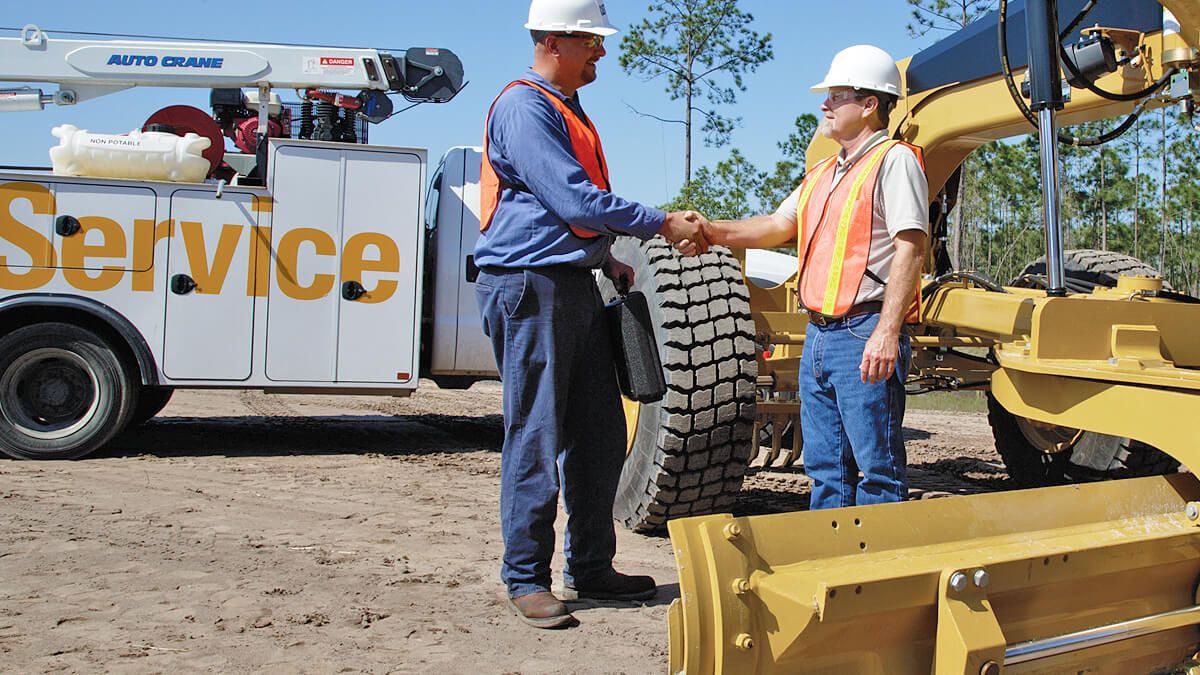

Sign In
Welcome! Sign In to personalize your Cat.com experience
If you already have an existing account with another Cat App, you can use the same account to sign in here
Register Now
One Account. All of Cat.
Your Caterpillar account is the single account you use to log in to select services and applications we offer. Shop for parts and machines online, manage your fleet, go mobile, and more.
Account Information
Site Settings
Security
MAINTAINING CONSTRUCTION EQUIPMENT SAFELY
So you’re on a jobsite and something goes wrong with your Cat® equipment. It happens. You’ll want to conduct an inspection of your own before contacting a Cat dealer for assistance. But how do you conduct an inspection safely?
Maintaining construction equipment can be tough, and it’s sometimes challenging to isolate a problem on the job. Here are a few tips and tricks to accurately troubleshoot your machine, making sure you’re following maintenance procedures and keeping yourself protected.
1. Know the machine.
First, when you’re maintaining equipment, you’ll want to know the basics of how your machine operates. Make sure you understand the normal operation and the interaction of the machine systems. Is the symptom you’re experiencing a characteristic of normal operation? Or is the symptom a problem? Contact your Cat® dealer or refer to the Systems Operation in your Service Manual.
2. Identify the symptom.
Next, determine exactly what went wrong. Check the history of repairs of the machine — has there been any preventive maintenance? Ask about the performance of the machine prior to the problem. What time did the symptom first occur? What were the operating conditions at the time of the problem? What was the sequence of events prior to the failure? If you can figure out exactly what happened prior to the problem, you can begin to narrow down which part might be at fault.
You’ll want to verify the symptom by trying to duplicate it. Operate the machine and repeat the conditions that caused the failure as best you can. Keep an eye on the gauges inside the cab.
3. Examine fault codes.
Determine if the Equipment Control Modules (ECM) has detected any faults. A diagnostic code is used to specify each detected fault. Each component, such as switches and sensors, is referenced by a unique component identifier. You’ll want to be familiar with fault codes, especially any that recur. Sometimes fault codes can seem overwhelming, but knowledge of the fault codes you see regularly can help you diagnose the issues. Consult your manual or Cat dealer to read and understand your fault codes.
4. Inspect the machine.
Now, look for problems on your equipment. Take note of any unusual odors in the air. Listen for unusual noises. Conduct a visual inspection of your machine — which can be tricky, so make sure your machine is safely parked with the parking brake secured. Look around the machine and under the machine for items such as loose bolts, trash, oil leaks, coolant leaks, broken parts or worn parts. Then, inspect the condition of the attachments, hydraulic components, mechanical components and electrical components.
a. Hydraulics
Conducting a visual inspection of your hydraulic system? Never check for leaks with your hands. High-pressure air or fluids escaping through a pinhole leak can puncture the skin and cause serious injury. Use a piece of paper or cardboard instead to inspect your hydraulic lines, hoses and connections for leaks. You’ll be able to find a leak quickly without posing a danger to your health. Measure the oil on the machine’s oil levels, inspect the hydraulic tank for the proper level and inspect the machine for damaged or loose hydraulic components.
b. Mechanical system
Inspect the steps, walkways and handholds for damage or wear. Repair the components that are damaged or worn. Inspect those same areas for cleanliness. If necessary, clean the components to prevent further disrepair. Inspect all control linkages for damaged components or broken components, and look for damaged or loose mechanical components.
c. Electrical system
Inspect the lights for broken bulbs and lenses. Replace if the bulbs or the lenses are broken. Inspect the machine for loose or frayed wiring and loose and damaged electrical components.
5. Remote Troubleshooting can help.
If your machine has remote services capability, your Cat dealer can help you troubleshoot the symptom, no matter where you are. Use the Remote Services website to initiate a Remote Troubleshooting session. Your Cat dealer will connect to your machine and identify the problem while the machine is operating, saving you valuable downtime. This allows for repairs to be made correctly the first time. Similarly, your Cat dealer can provide necessary software updates for your equipment using Remote Flash, keeping your jobsite moving without having to wait for a technician to arrive to do it for you.
Contact your Cat dealer to see if your equipment is eligible for remote services and get signed up today.
6. Problem solved? Keep a record.
Have you discovered the issue and made repairs? Complete a maintenance record for the machine: problem, symptom and repairs. Refer to the instructions in the Operation and Maintenance Manual for your machine. Then prepare your machine for operations and get back to work.
Still need assistance? Contact your Cat dealer for more help.
